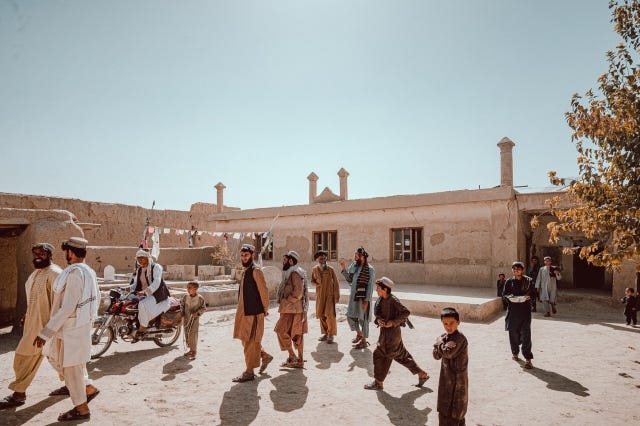“Fly on, little wing.”
-Jimi Hendrix
It has been almost seven weeks since the Taliban stunningly took control of the Presidential Palace – and subsequently the entire country – and slowly life is returning to a new normal, except of course for girls’ education which sadly remains halted.
In addition to that major injustice, is the crippling economy which I fear will have major repercussions on the safety and stability of Afghanistan.
DISPATCH: NEWLY APPOINTED TALIBAN OFFICIAL CLAIMS ROLE IN EXTORTION 17 SHOOTDOWN
In a stuffy office covered with white-and-black Islamic Emirate of Afghanistan flags and full of Taliban foot soldiers sipping cold tea, Akif Muhajer sits poised and composed, every bit the administrator he now is as the newly appointed director of information and culture in the Taliban-controlled Logar province.
But from behind his desk, he speaks casually about his many years waging war in the mountains, his weapons, and the battles he saw.
He says one of those battles — or at least moments of combat — was the 2011 shootdown of Extortion 17, the deadliest single moment of the 20-year war for the American military.
“It was a good and bad memory of my life,” he says. “Losing friends was a bad memory, but [it was] good because our friends shot down American helicopter.”
Muhajer never flinches as he tells his story, but he also never looks my way, as I am a woman. He says he wasn’t the one who fired the rocket-propelled grenade; it was a “friend of his” hiding out with him.
It’s a remarkable boast. Extortion 17 was among the Taliban’s greatest single moments of battlefield triumph in the 20-year war with US forces, and one with which a young Taliban official might be tempted to associate himself.
To reach the crash site, one must wind slowly through the ancient, narrow streets of the Tangi Valley in Wardak. Just two months ago, its streets were deemed too dangerous for an American to journey through. Children play in the strips of green and wander barefoot through the endless graveyards, each of the dead commemorated with a blank slab of rock as a headstone and sometimes a withered Taliban flag.
Finally, the lush greenery emerges between the primitive huts. It’s a parcel locals refer to as the ultimate Taliban base throughout much of the 20-year occupation. Disabled men huddle in a group on the dirt; they’re another visceral reminder of the war waged here.
Memorials for the Taliban fighters Americans killed in retaliation for the Extortion 17 shootdown languish.
READ MORE ABOUT THE EXTORTION 17 CLAIMS HERE
TALIBAN’S RETURN TO POWER IN AFGHANISTAN LEAVES FEMALE JOURNALISTS IN UNDEFINED TERRITORY
“What do you really do?” the Taliban commander seethed from inside their police station holding cell last week. “How do I know these aren’t fake?”
He sneered at my press card and the permission letter issued to me by the Taliban Media Office — officially termed the Islamic Emirate of Afghanistan — giving me legal authorization to continue working in the conflict-plagued country that suddenly fell into Taliban control in mid-August.
However frustrated I was growing inside the suffocating space, I drew a deep breath and remained calm.
Hours in detainment had already passed as more and more high-ranking Taliban security and intelligence officials entered the small interrogation room in Spin Boldak, which borders Pakistan, all armed with American-made M4s and the veiled accusation that my photographer and I surely had to be spies. It’s an unfortunate tag that these days befalls almost all journalists working in nefarious places, and one that needless to say ratchets up the danger level of the profession.
Eventually, after much arguing and then the coveted clearance from the Taliban top brass, we were released back into the wild to continue covering the rapidly deteriorating humanitarian crisis unfurling at the international crossing.
I realized how many governance challenges lay ahead for this new regime of fighters from the mountains, now swept into running a country of 38 million virtually overnight. I also realized that this experience marked the first time in my month of working behind Taliban lines in Afghanistan that their officials had treated me exactly the same as my male photographer, Jake Simkin.
These Talibs had looked me dead in the eyes. They had made no effort to shield me from the stress of the situation. That in itself was a rapid departure from the newly empowered Taliban I have come to know, which for the most part treats girls and women as property along with land or gold or a ladle from a kitchen drawer.
READ MORE ABOUT MY EXPERIENCES AS A FEMALE REPORTER IN TALIBAN TIMES HERE
THE IDEOLOGY BEHIND HOW THE TALIBAN WON THE WAR
Bumping through the narrow tracks lined with primitive mud huts and curious, crinkled faces, the blistered remnants of two decades of conflict are raw. Yet, despite the trillions poured into Afghanistan, the journey from Kandahar city to the secluded mosque where it all began are also searing reminders that the country is still one of the poorest on earth.
And it was inside one lone, flesh-colored room with a dank brown prayer mat across the cool cement floor and a broken clock with the word “victory” emblazoned in English that Mullah Mohammad Omar brought together the most impoverished of his followers to form the Taliban movement in 1994. It was his rallying cry for Jihad that spawned the deep-seated ideology that no amount of money nor prowess from the most potent and expertly-equipped military on the planet — the United States — could defeat for good.
“Due to the war, studies stopped here, but still people haven’t stopped coming to pray,” stresses Mawlawi Hayat Khan, 49, who has filled Omar’s shoes as the Imam for the past seven years.
Outside, there is a clay room with small squares carved as windows. Until the 2001 U.S. incursion, it served as the madrassa to indoctrinate the up-and-coming generation of mountain militiaman. Although it has not been used in the decades since, locals say Mullah Omar’s son Mohammad Yaqoob — the country’s newly-appointed Minister of Defense who they remembered milling around as a tiny boy — has pledged to soon build them another close by.
Haji Abdul Majeed Ustad, a 72-year-old village elder, says that people were drawn to Mullah Omar’s stringent stance against corruption and believed — still believe — that the movement is against self-seeking profiteers.
“People would donate food and other items for Mullah Omar to live on. Men and women stood with Mullah Omar because he stood against gunmen in the area at that time. People took hammers, shovels and guns whatever they could find to stand against the looters,” he recalls. “That is how Jihad started and ultimately reached Kabul. It was the training and teachings of Mullah Omar that people stood for – he was not a thief or someone who would do corrupt practices. That’s why he was very much respected, and people would continue the fight by his words.”
Ustad asserts that people resonated with his sermons on recognizing Jihad as better than oneself and preparing to sacrifice themselves for the cause to stand against “Islam’s enemies.”
READ MORE ABOUT THE IDEOLOGY HERE
MOST AFGHAN PRISONERS ARE DRUG ADDICTS SWEPT UP FROM THE STREETS
At the edge of Afghanistan’s second-largest city, inside the Kandahar Province Central General Prison, hundreds of men dot the depilated courtyard. Some squat alone outside the heavy cell doors with bloodshot eyes staring into the early morning light, and others cluster around a single water fountain filling plastic buckets to wash away waste in the latrines – their thin bodies writhing. One inmate prays on a large red mat sprawled over a cement slab, and dozens more cluster about.
Ten percent of the approximately 700-person prison population are considered to be convicted or accused criminals – murderers, thieves, drug dealers and traitors. The rest are drug addicts who have been swept from the streets in the weeks since the Taliban came to power in mid-August.
“When they first came in, they were in too much pain, and we were not ready for it,” says Haji Mansour, the 38-year-old Taliban prison commander. “But we have improved it a lot. We have doctors, and some go to the hospital for a few days and return back.”
Without funding for formalized rehabilitation programs, the Taliban has taken to arresting drug addicts from the street and putting them behind bars in a bid to initiate a more orderly rule across the country and eliminate the “haram” – forbidden – practice of drug use.
Mansour explains that the Taliban intends to keep the addicts behind bars between 40 days and six months, or however long it takes to establish courts and for a judge to rule on their case. However, the onus will then be on their families to ensure they don’t backslide.
“The family must accept the guarantee that they won’t touch the narcotics anymore, and in a month (after their release), we will get to check,” he continues. “In the previous government, people still came to the jails and were providing for the inmates.”
He didn’t respond to questions on whether families would be subsequently punished for re-offending but stressed that relatives are sometimes the ones who hand addicts over to the authorities “for their safety.” But more commonly, users are arrested by the Taliban patrolling the streets.
READ MORE ABOUT THE OPIOD ADDICTS HERE
AMERICA ENDED ITS FOREVER WAR, BUT AFGHANISTAN’S CONFLICTS CONTINUE
Many are sick and dying, and some are pushed in wheelbarrows — the concept of a wheelchair unthinkable to the cash-strapped and desperate. And although these ailing women, children and entire families are only steps from the Pakistan crossing into the Chaman and Quetta, they are denied the entry that once came freely to them.
Pakistan’s sudden shuttering of the border, citing its own national security concerns and the fact that it has absorbed far more Afghan refugees throughout the decades of conflict than any other country has allowed to enter, has incensed the newly minted Taliban border guards.
“We have an understanding with Pakistan to let Afghans through on humanitarian and medical grounds,” a Taliban official, 28-year-old Mohammad Sadiq Sabery, asserts angrily.
Perishable goods rot in piercing heat, with trucks having been backed up for weeks. Embattled merchants who have survived through the years of conflict by cross-country imports and exports now wildly bemoan that they can no longer afford to put food on the table.
The border chaos, replete with people desperate to tell their stories of death and destruction, marks a small snippet of a nation sliding into mayhem and madness some six weeks since the Taliban takeover, followed by the frenetic U.S. departure last month.
Immediately after Afghan President Ashraf Ghani fled on Aug. 15, allowing the Taliban’s then-militia in the mountains to seize the reins of a nation of 38 million, Washington froze more than $9 billion in reserves to the country’s central bank. It was the U.S. taxpayer who propped up Afghanistan’s ailing economy for almost two decades. The World Bank and the International Monetary Fund suspended loans, and the Financial Action Task Force, a Paris-based group that monitors global terror, mandated its member nations cut off Taliban money.
With each passing day, the crisis only deepens.
Many public services, including those in the health sector, have stopped. Girls’ education has halted, with Taliban officials claiming to me that they don’t have the financial resources to ensure the complete segregation of genders, as per their stringent interpretation of Islamic values.
But given the Taliban’s 20-year track record waging war against the government and slaying thousands of American troops in the process, coupled with steep concerns over its policies pertaining to human rights, the international recognition the regime so desperately craves is not likely to come anytime soon.
Thus while one war has technically ended, it feels as though another is just beginning. This one may lack the bombs and bullets of the past, but Afghanistan remains a bleeding place. And it is always the civilians who suffer.
The cost of food and essential items is increasing by the day, exacerbated by rapid inflation. The value of national currency, the Afghani, is subsequently falling, and there is a grave shortage of hard cash.
READ MORE ABOUT THE ECONOMIC AND HUMANITARIAN CATASTROPHE IMPACTING AFGHANS
Follow me on Instagram and Twitter for more updates
Photos courtesy of my brilliant photographer @JakeSimkinPhotos. Please consider a paid subscription to allow us to continue this work.















